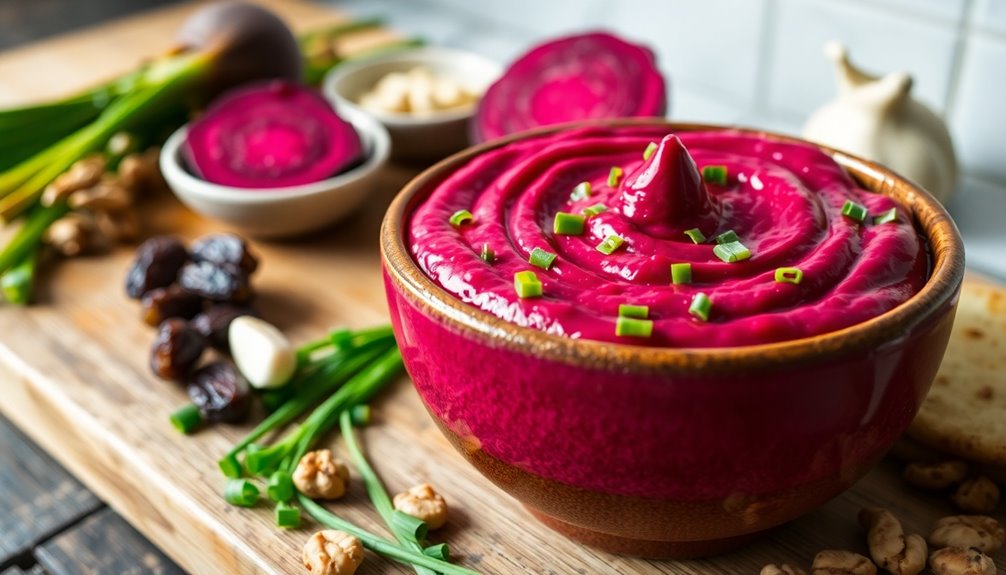Beetroot caviar's a vibrant and nutritious dish that dazzles with its ruby-red color and earthy flavor. Made from roasted beets, dried dates, and garlic, it makes a perfect appetizer or garnish. You can serve it with crackers, cheese, or alongside meats and salads to elevate your meal. Plus, it's a healthy choice packed with vitamins and antioxidants. If you want to learn how to make this stunning dish and more about its benefits, keep exploring!
History

Although beetroot caviar might sound like a luxurious delicacy, it actually has roots in Eastern European cuisine as a vegetarian alternative to traditional fish caviar.
This dish emerged in the USSR, where it served as an economical substitute for pricey fish caviar, using affordable ingredients like beetroot and cucumbers.
Historically, beetroot has been a staple in Slavic cuisine, commonly featured in soups and salads. This laid the groundwork for innovative dips like beetroot caviar.
The term "caviar" reflects a cultural adaptation, adding a touch of elegance to a dish that was otherwise accessible to everyday consumers.
Over time, beetroot caviar recipes evolved, incorporating local flavors, making it a beloved choice in modern vegetarian and vegan diets.
Recipe

Beetroot caviar is a delicious and visually appealing dip that brings a burst of color and flavor to any table. The earthy sweetness of roasted beets, paired with the rich notes of dates and a hint of garlic, creates a delightful combination that's both nutritious and satisfying. This versatile dip can be enjoyed with a variety of dippers, making it a perfect choice for parties, gatherings, or a healthy snack.
To prepare beetroot caviar, you'll need to roast the beets to enhance their natural sweetness and depth of flavor. Once roasted, the beets are blended with ingredients that add creaminess and a touch of sophistication. The result is a smooth, flavorful spread that can be adjusted to suit various dietary preferences by swapping out ingredients as needed.
Ingredients:
- 2 medium beets
- 4 dried dates (or dried figs)
- 1 clove garlic
- 2 tablespoons cognac (optional)
- 1/4 cup cream or Greek yogurt
- Salt and pepper to taste
- Chives or nuts for garnish (optional)
Cooking Instructions:
Preheat your oven to 400°F (200°C). Wrap the beets in aluminum foil and roast them in the oven for about one hour, or until they're tender when pierced with a fork.
While the beets are roasting, soak the dried dates in warm water for about 10 minutes to soften them. Once the beets are done, allow them to cool slightly before peeling off the skins.
In a blender, combine the roasted beets, soaked dates, garlic, cognac (if using), and cream or yogurt. Blend until smooth and creamy, then season with salt and pepper to taste.
Extra Tips:
For an added layer of flavor, consider experimenting with different herbs or spices, such as cumin or smoked paprika.
You can also adjust the consistency of the dip by adding more cream or yogurt if desired. To elevate the presentation, serve the beetroot caviar in a beautiful bowl and sprinkle with chopped chives or your favorite nuts for a crunchy texture.
Enjoy this dish fresh, as it tastes best when served immediately, but it can also be stored in an airtight container in the refrigerator for up to four days.
Cooking Steps

To get started on your beetroot caviar, preheat your oven to 400°F and roast those medium beets until they're tender.
Once they're cool, chop them finely and mix in your walnuts and chives for added flavor.
Don't forget to add the dates and crème fraîche, then adjust the seasoning to make it just right for your taste!
Step 1. Preheat Oven to 400°F

Preheating your oven to 400°F is crucial for roasting beets to perfection. This temperature ensures they cook evenly, allowing their natural sweetness to shine through.
Before you start, wash and trim the beets to remove any dirt that might affect their flavor.
Once the oven reaches the right temperature, place the beets inside and roast for about 1 hour. This process deepens their earthy flavors and enhances their sweetness.
To check if they're done, simply insert a fork or knife into the beets; they should be easily pierced when fully cooked.
After roasting, you can peel and chop them, setting the stage for your delicious beet caviar mixture.
Enjoy the rich taste of perfectly roasted beets!
Step 2. Chop Roasted Beets Finely

Once your roasted beets have cooled enough to handle, it's time to peel them. Use a sharp knife to carefully remove the skin, discarding any tough or blemished parts.
After peeling, finely chop the roasted beets into small, uniform pieces. This step is crucial for achieving the right texture in your beet caviar. The finer you chop, the smoother the final spread will be.
If you prefer a bit more texture, you can leave some larger pieces, but aim for consistency overall.
Don't forget, the chopped beets can be mixed with flavors like garlic or herbs right after chopping to enhance their taste.
Enjoy the vibrant color and unique flavor of your homemade beet caviar!
Step 3. Mix in Walnuts and Chives
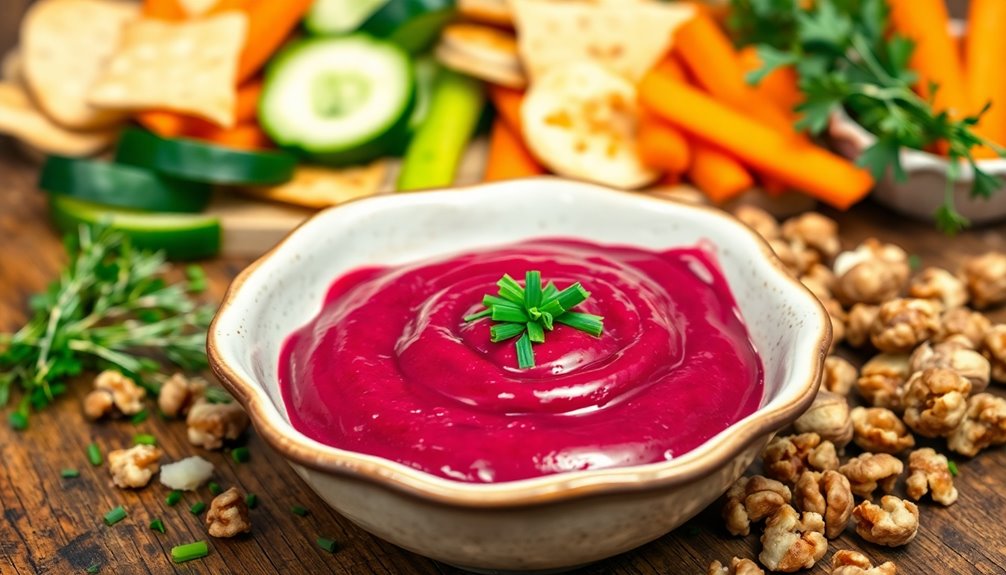
As you prepare to elevate your beetroot caviar, mixing in finely chopped walnuts and chives brings an exciting burst of flavor and texture.
Start by pulsing about 1/4 to 1/2 cup of walnuts until they're finely chopped, adjusting based on how crunchy and rich you want your dip to be.
After blending the roasted beetroot and other ingredients into a smooth dip, gently fold in the walnuts. This keeps the consistency just right.
Next, add chopped chives to introduce a fresh, onion-like flavor that beautifully complements the earthiness of the beets.
For an appealing presentation, sprinkle some extra chives on top just before serving.
Enjoy your vibrant beetroot caviar with its delightful crunch!
Step 4. Add Dates and Creme Fraiche
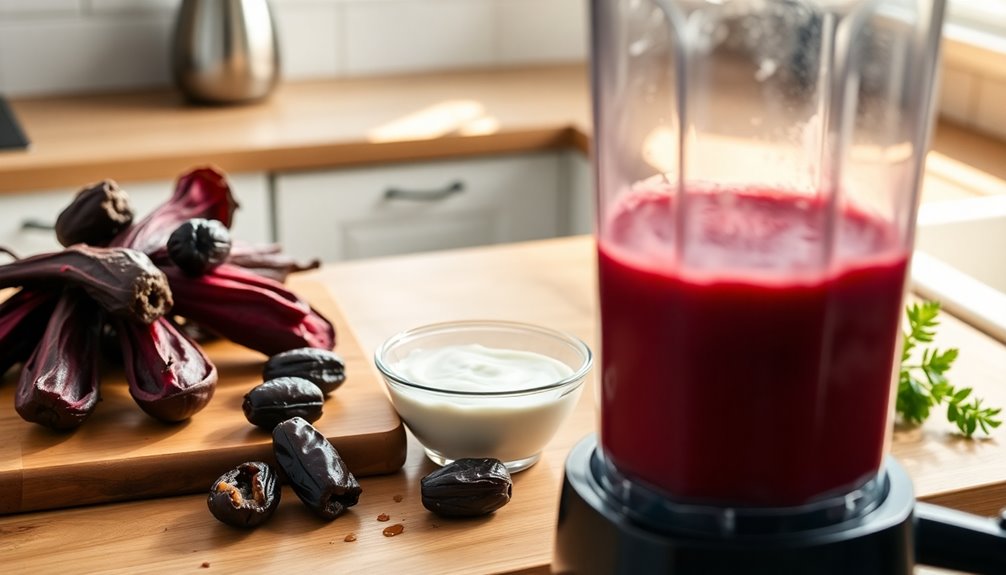
To enhance your beetroot caviar, start by soaking 5 plump pitted and chopped dates in 2 tablespoons of heated cognac for at least 10 minutes.
Once your beets are roasted and cooled, peel and chop them, then blend them with the soaked dates, cognac, and 4 smashed garlic cloves until you reach your desired texture.
Next, incorporate 3 tablespoons of crème fraîche or cream cheese to add creaminess, balancing the flavors beautifully.
For a smoother beetroot dip, add more cream or blend longer; for a chunkier spread, pulse briefly.
Finish off with a splash of lemon juice and a pinch of salt. Drizzle with olive oil for an elegant touch, and enjoy your vibrant dish!
Step 5. Adjust Seasoning to Taste
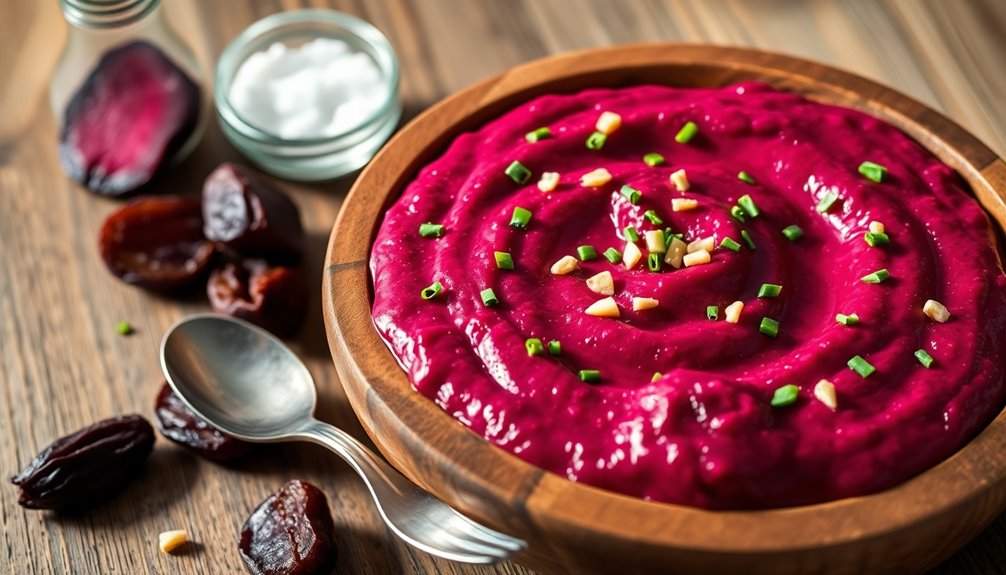
Adjusting the seasoning in your beetroot caviar is essential for bringing out the best flavors. Start with a base of salt and pepper to enhance the natural sweetness of the beets.
As you blend, taste the mixture and gradually incorporate lemon juice to add acidity, balancing that sweetness and brightening the dish. Don't rush this step—adjust seasoning carefully to ensure the flavors develop without overpowering the beets.
Once you're satisfied, stir in fresh herbs like chives, dill, or parsley for an aromatic freshness that complements the earthy notes.
If you've added nuts or creamy elements, taste again and adjust seasoning accordingly, ensuring a harmonious balance throughout your beetroot caviar.
Enjoy crafting your perfect blend!
Final Thoughts
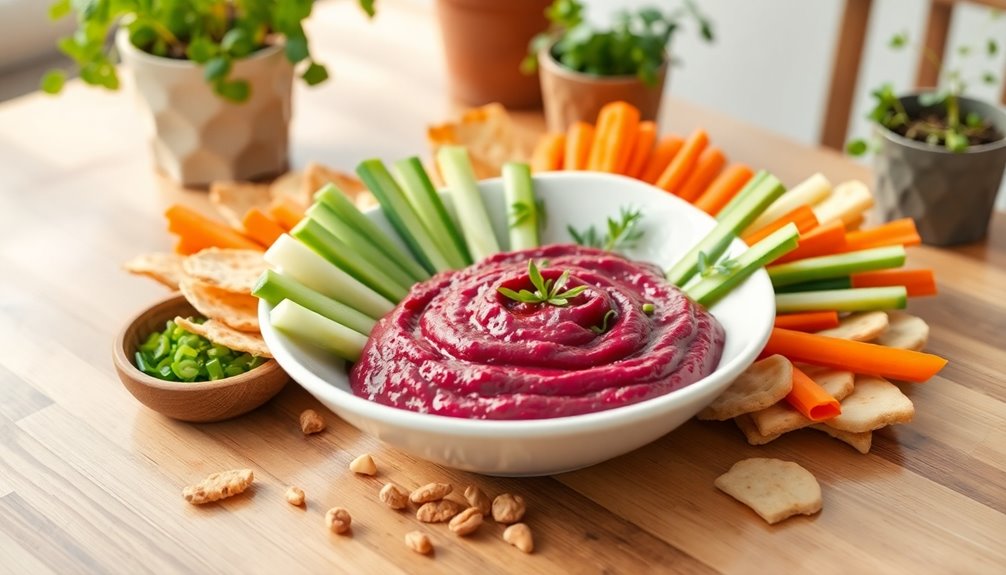
While exploring creative alternatives to traditional caviar, beetroot caviar stands out as a delicious and visually stunning option. Its vibrant ruby-red color and unique flavor make it an enticing dip for any occasion.
Plus, it's gluten-free and caters to various diets, making it accessible for everyone. You can enjoy beetroot caviar spread on rye bread, paired with crackers, or as a dip for fresh vegetables, enhancing its versatility for appetizers and snacks.
The preparation process is straightforward, involving roasting or boiling beets and blending them with ingredients like garlic and pickled cucumbers.
Feel free to elevate the experience by adding cognac or nuts for a personalized touch. This dish not only pleases the palate but also adds a pop of color to your table.
Frequently Asked Questions
What Is Mexican Caviar Made Of?
Imagine hosting a lively fiesta, and you want to impress your guests with a vibrant dip.
Mexican caviar, or "caviar de salsa," is made from finely diced tomatoes, onions, cilantro, jalapeños, and fresh lime juice. This colorful mix bursts with flavor and pairs perfectly with tortilla chips or tacos.
You can even customize it with ingredients like avocado or corn for extra texture. It's a festive, vegetarian option that everyone will love!
What Is Vegetarian Caviar Made Of?
Vegetarian caviar typically includes plant-based ingredients that mimic the texture and appearance of traditional caviar.
You'll often find it made from ingredients like seaweed, agar agar, or various vegetable purees.
Common flavor enhancers include garlic, onions, and spices, which add depth to the dish.
It's a versatile option, and you can experiment with different vegetables or seasonings to create a unique taste that suits your palate while being entirely meat-free.
Why Is Beetroot so Expensive?
Beetroot can be pricey due to several factors.
Seasonality plays a big role; when supply dips during off-peak months, prices tend to rise.
If you're looking at organic options, the increased labor and resources for cultivation also drive costs up.
Plus, transportation expenses add to the price, especially for long-distance sourcing.
Specialty varieties, with their unique flavors, appeal to gourmet markets, further pushing up the price as demand grows.
What Does Beetroot Taste Like?
When you taste beetroot, you'll notice its sweet, earthy flavor, often compared to sweet carrots or parsnips.
If you try it raw, you might catch a hint of bitterness, but roasting brings out its natural sweetness.
Blending it into a dip or spread enhances its rich flavor, especially when mixed with garlic or vinegar.
Its vibrant color and unique taste make beetroot a delightful addition to both sweet and savory dishes.
